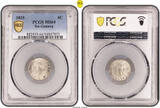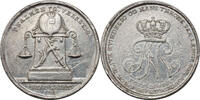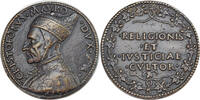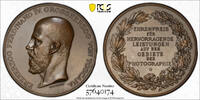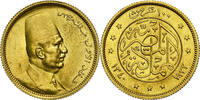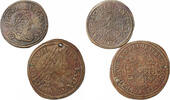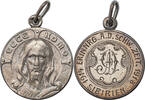MA-ID: 107402454
Customer feedback Stankov
Gran profesional,todo perfecto
ok
Everything OK.
Perfekt !
Switzerland-Geneva 4 Centimes 1839 PCGS MS64
Filip Stankov eU 

2
On MA-Shops since 2 years
435 ratings,
100 % Positive (last 24 months)
Worldwide shipping
108.37 £125,00 EUR
Discount 34.68 £ / 24%
Import tax may be added
+ 13.00 £ shipping ( to United Kingdom )
Delivery time: 8 - 12 days
+ 13.00 £ shipping ( to United Kingdom )
| Customer Support +49 (0)2871 2180 383 |
| Payment methods |
| Wire Transfer |
1839, Switzerland, Geneva (Canton). Billon Silver 4 Centimes Coin. PCGS MS-64!
Mint Year: 1839
Denomination: 4 Centimes
Reference: HMZ 2-368a, KM-127.
Mint Place: Geneva (Free & Independant City)
Condition: Certified and graded by PCGS as MS-64!
Material: Billon (low grade silver & bronze alloy)
Diameter: 18mm
Weight: 1.8gm
Obverse: Illuminated initials (" IHS") above round arms of Geneva (Crowned Eagle / Key).
Legend: POST . TENE BRAS . LUX . * .
Reverse: Value (4), denomination (CENTIMES) and date (1839) in three lines.
Legend: REP . ET . CANT . DE GENEVE
In the Latin-speaking Christianity of medieval Western Europe (and so among Catholics and many Protestants today), the most common Christogram is "IHS" or "IHC", denoting the first three letters of the Greek name of Jesus, iota-eta-sigma, or ??S. The Greek letter iota is represented by I, and the eta by H, while the Greek letter sigma is either in its lunate form, represented by C, or its final form, represented by S. Because the Latin-alphabet letters I and J were not systematically distinguished until the 17th century, "JHS" and "JHC" are equivalent to "IHS" and "IHC".
From the beginning the bishopric of Geneva was a suffragan of the archbishopric of Vienne. The bishops of Geneva had the status of prince of the Holy Roman Empire since 1154, but had to maintain a long struggle for their independence against the guardians (advocati) of the see, the counts of Geneva and later the counts of the House of Savoy. In 1290 the latter obtained the right of installing the vice-dominus of the diocese, the title of Vidame of Geneva was granted to the counts of the House of Candia under count François de Candie of Chambery-Le-Vieux a Chatellaine of the Savoy, this official exercised minor jurisdiction in the town in the bishop's. In 1387 Bishop Adhémar Fabry granted the town its great charter, the basis of its communal self-government, which every bishop on his accession was expected to confirm. When the line of the counts of Geneva became extinct in 1394, and the House of Savoy came into possession of their territory, assuming after 1416 the title of Duke, the new dynasty sought by every means to bring the city of Geneva under their power, particularly by elevating members of their own family to the episcopal see. The city protected itself by union with the Swiss Federation (German: Eidgenossenschaft), uniting itself in 1526 with Berne and Fribourg.
Mint Year: 1839
Denomination: 4 Centimes
Reference: HMZ 2-368a, KM-127.
Mint Place: Geneva (Free & Independant City)
Condition: Certified and graded by PCGS as MS-64!
Material: Billon (low grade silver & bronze alloy)
Diameter: 18mm
Weight: 1.8gm
Obverse: Illuminated initials (" IHS") above round arms of Geneva (Crowned Eagle / Key).
Legend: POST . TENE BRAS . LUX . * .
Reverse: Value (4), denomination (CENTIMES) and date (1839) in three lines.
Legend: REP . ET . CANT . DE GENEVE
In the Latin-speaking Christianity of medieval Western Europe (and so among Catholics and many Protestants today), the most common Christogram is "IHS" or "IHC", denoting the first three letters of the Greek name of Jesus, iota-eta-sigma, or ??S. The Greek letter iota is represented by I, and the eta by H, while the Greek letter sigma is either in its lunate form, represented by C, or its final form, represented by S. Because the Latin-alphabet letters I and J were not systematically distinguished until the 17th century, "JHS" and "JHC" are equivalent to "IHS" and "IHC".
From the beginning the bishopric of Geneva was a suffragan of the archbishopric of Vienne. The bishops of Geneva had the status of prince of the Holy Roman Empire since 1154, but had to maintain a long struggle for their independence against the guardians (advocati) of the see, the counts of Geneva and later the counts of the House of Savoy. In 1290 the latter obtained the right of installing the vice-dominus of the diocese, the title of Vidame of Geneva was granted to the counts of the House of Candia under count François de Candie of Chambery-Le-Vieux a Chatellaine of the Savoy, this official exercised minor jurisdiction in the town in the bishop's. In 1387 Bishop Adhémar Fabry granted the town its great charter, the basis of its communal self-government, which every bishop on his accession was expected to confirm. When the line of the counts of Geneva became extinct in 1394, and the House of Savoy came into possession of their territory, assuming after 1416 the title of Duke, the new dynasty sought by every means to bring the city of Geneva under their power, particularly by elevating members of their own family to the episcopal see. The city protected itself by union with the Swiss Federation (German: Eidgenossenschaft), uniting itself in 1526 with Berne and Fribourg.
| Shipping fees | ||||
|---|---|---|---|---|
| up to 60.69 £ | 86.70 £ to 260.09 £ | 260.09 £ to 1,733.90 £ | 1,733.90 £ to 30,343.26 £ | |
| Germany | 8.67 £ | 10.40 £ | 13.00 £ | 21.67 £ |
| Austria | 6.94 £ | 8.67 £ | 10.40 £ | 19.94 £ |
| United States | 43.35 £ | 43.35 £ | 43.35 £ | 30.34 £ |
| European Union | 8.67 £ | 13.00 £ | 17.34 £ | 21.67 £ |
| World | 11.27 £ | 13.00 £ | 21.67 £ | 30.34 £ |
Information
Online orders are welcome as always and will be shipped directly.
|
Seller Home | 0Shopping cart | Terms of sale | Contact | MA Terms of sale | Privacy policy | Warranty | MA-Shops New Items Copyright ® 2001-2025, MA-SHOPS Coins All Rights Reserved. Designated trademarks and brands are the property of their respective owners. |
 Buy coins with warranty
Buy coins with warranty




